June I 1941 — Axis Turn
Initial Phase
Per special rule (p.89 of the MN rules), all Vichy forces are considered in general supply and one turn they can all be considered in Offensive Supply. The Axis select this to be that turn. ⅓ LP spent for air. No Allied forces are isolated, and the air units that were E-1, and flew to Palestine, are checked for supply per Rule 15.H.2.b.i. Because they now have an source of supply (the RSR to the QM in Haifa) they are back in normal supply (supply status otherwise awaits the next Allied Initial Phase).
0.5 wing of D.520 fighters and 1 wing of Le0451 bombers arrive as reinforcements. Fighters are placed at Beirut and the bombers at Homs.
Air units are assigned to naval cooperation and gunnery spotting. The Axis assign the units in Rhodes (except the Night bombers) and the POs, as last turn, to naval co-op. Allied Beaufighters, Wellingtons, and FAA units are assigned on the Allied side (as they must be, as they are naval-coded).
Movement Phase
Airbase Attacks. The Axis forgo airbase attack missions, given their slender assets. The Allies will target the newly-arrived bombers in Homs. The force that transferred from Iraq leads the attack. 3 squadrons of Hart assault bombers, the Audax recon planes, escorted by extended range Tomahawk from El Arish fly to Homs. Vichy elects to intercept with the D.520 squadron from Beirut:
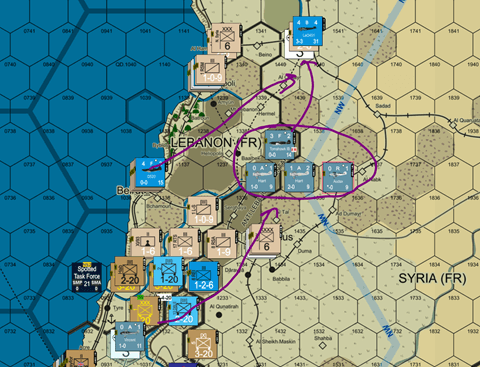
In the ensuing ATAC (Air-to-Air Combat), the fighters are automatically paired against one another. The Vichy Fighters could attempt to bypass the escorts to get a crack at the bombers (11.C.4.a.ii.1 and 11.C.4.c). In that case, the D520s cannot fire at the Tomahwaks but the latter fire with a +3 DRM (modified to +4 because of net ACEV difference). At extended range, the Tomahawks would fire with an attack of 2 (reduced .75 from 3 because of range) against a defense of 3. Even on the -1 column, the +4 DRM would automatically bounce the Vichy fighters. So the D520s fight the escorts. The Vichy roll on the +2 column (-1 for net ACEV) is a 5, which does not hurt the British (an R). The British achieve the same result. So no effect.
The bombers deliver 3.5 OBFs. 3 OBFs place 1 hit on Homs airbase and eliminate a squadron of Vichy bombers (3 OBFs needed). The ancient CW planes have some value. The extra 0.5 OBFs gives a chance (0.5/3) of a second hit, but the 1 in 6 chance msses.
Naval spotters.
The Allies no longer need naval spotters. The Axis assign the long-range search planes on Rhodes and the French POs to such duty. The Allied NTG is no longer spotted with the passing of the player turn; but several opportunities to spot it await.
Naval Movement Phase
The Axis have no naval movement; but they can run naval co-op missions. The first order of business is to seek to spot TF 21, off the Lebanese coast. As Vichy controls land area adjacent to the relevant Sea Zone, coastal spotting can be used (9.I.9). The DRM is +1 per table. A roll of 10 finds the British TF. This triggers an air strike from the anti-shipping forces base at Rhodes. As before, they must roll (8.L) to find the TF. Rolls of 2 and 5, however, fail. So no strikes occur.
The ships that returned to Haifa (TF17) replenish fuel, provisions, and ammo (including all important gunnery, as NGS reduced it significantly). Haifa is a naval base and, per charts, can refuel 200 FPs/turn. The force replenishing takes far less than that (7). She will be ready to sail again next NMS (15.X.7). TF21 could sail up the coast and bombard facilities (13.Q.1.a); but it stays stationary (8 more SMAs; 3d segment at sea) to provide shore support (NGS) in the event of a Vichy counter-attack along the coastal strip.
Ground Movement
The Vichy plan is an active defense. And that means counter-attacking the small CW force! But first a series of defensive moves: (1) the Artillery that survived Aleppo uses operational movement to exis the reduced ZOI of the Indian Xs (3 MPs); moves two hexes (2 MPs) and then moves to Homes (11 MPs total; had 12); (2) the HQ and Brigade near Tripoli garrison the town; (3) 1 SP equivalent of engineers (2 IIs) in Beirut fortify; they can dig a 1-level fort for 5 MPs (14.B.3.a-b):
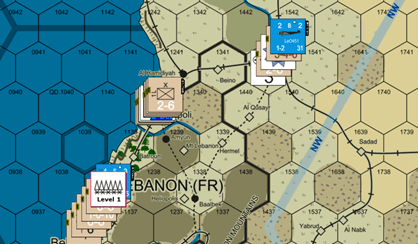
In the South: Vichy forces fall back on Beirut and Damascus; but all mobile forces gather on the Golan flank for a counter-strike aimed at the Indian X. This includes some forces using the small Levant Railway network to move into position (reduced from 5 to 3.5 SPs because of the fall of Aleppo, see 7.F.1.a.vi) [not shown here, one French III stays south of Beirut until the Pursuit phase to deny the Allied front line unit Reaction moves].
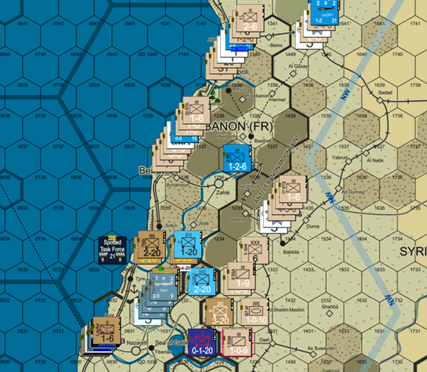 .
.
Other air missions occur before the Combat phase. The British Valentia B/Ts in Habbaniyah will fly GSPs to Aleppo. The mission is extended range, so cargo capacity is halved to 0.25 SPs, sufficient to carry a single GSP. Blenheims in Iraq transfer to Palestine. The Allies also activate (once per game) Bombay transports in Egypt. We assume GSPs are available there from a stray ⅓ LP; and 2 GSPs are flown to Aleppo on an extended range mission.
Combat Phase
Vichy declares a combat in the Golan against the Indian X. The German NBs fly CAS. They cannot be intercepted by the Allied day fighters; they will add, at long range, 3 x 0.25 x .25 factors (0.1875). Vichy also sends the Leo451s. They are intercepted by Hurricanes. The British fighters shoot them down with an 8 (+1 column; +1 DRM for fighter superiority and +1 for ACEV). The Allies send Blenheims (short range), and Maryland bombers, which adds 3.5/4 combat factors. Defense is 3×1.3 (CEV) +the air, or 4.775. Too far from the sea for naval support. Vichy attack is as follows:
-
Cavalry attacking infantry that is not in a Division or with artillery gives Cav Effects (see 10.L.7). 3 printed x 1 (CEV) x 1.5 (terrain) x 1.5 (Cav effects) = 6.75.
-
1 Tank III: 1 x 1 (CEV) x 1.5 (terrain) = 1.5
-
Air: 0.1875.
Total = 8.43.
DRMs are +1 for concerted attack, -3 for all 3 air modifiers in the Allies’ favor (3 CAS squardons to 2; fighter superiority for theatre and hex). The French also have an SP of tanks, with adds +1 for ASE (10.L.1). So net is -1. The combat rounds (roll of 30) to 2:1 -1:
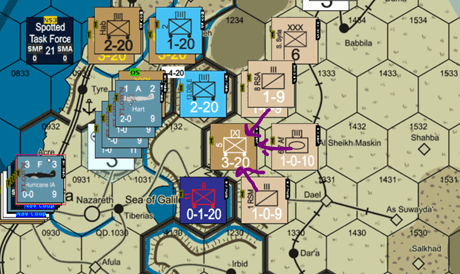
Vichy needs help, and they roll for surprise on the success table. However, unlike the Allied Commando raid, if it fails, the combat is -4. Vichy rolls on the success table. The roll is a “7” which succeeds (barely). The attack becomes 2:1 +1 rather than -1. The combat roll is a HQ. The Allies could have used a battalion stacked with the Brigade to take the quarter loss. The Indian X is eliminated. Vichy loses 1 SP, in this case a Cavalry regiments. There is no advance. There are no allied combat replacements, as Allies do not hold the hex. The Cav regiment yields ⅓ an SP replacement (which Vichy will not quite have the chance to use).
Reaction
The Allies have a hole in their lines. Fortunately, Layforce unloaded in Haifa is available. It scampers to 1132:
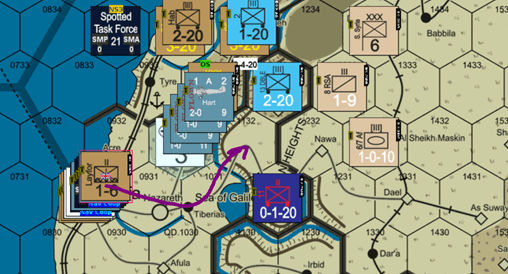
Pursuit
In the naval segment, Allied TF 21 retires to Haifa, to replenish the following turn. VIchy’s surviving mobile forces pull back. End of Turn:

